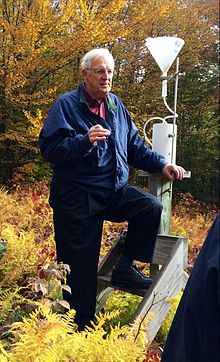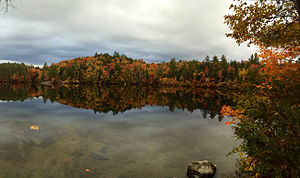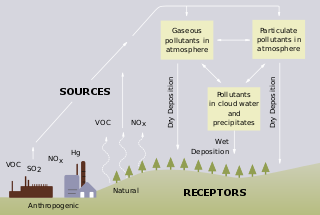
Acid rain is rain or any other form of precipitation that is unusually acidic, meaning that it has elevated levels of hydrogen ions. Most water, including drinking water, has a neutral pH that exists between 6.5 and 8.5, but acid rain has a pH level lower than this and ranges from 4–5 on average. The more acidic the acid rain is, the lower its pH is. Acid rain can have harmful effects on plants, aquatic animals, and infrastructure. Acid rain is caused by emissions of sulfur dioxide and nitrogen oxide, which react with the water molecules in the atmosphere to produce acids.

Limnology is the study of inland aquatic ecosystems. The study of limnology includes aspects of the biological, chemical, physical, and geological characteristics of fresh and saline, natural and man-made bodies of water. This includes the study of lakes, reservoirs, ponds, rivers, springs, streams, wetlands, and groundwater. Water systems are often categorized as either running (lotic) or standing (lentic).

Hubbard Brook Experimental Forest is an area of land in the towns of Woodstock, Ellsworth and Thornton in the White Mountains of New Hampshire that functions as an outdoor laboratory for ecological studies. It was initially established in 1955 by the United States Forest Service for the study of the relationship between forest cover and water quality and supply.
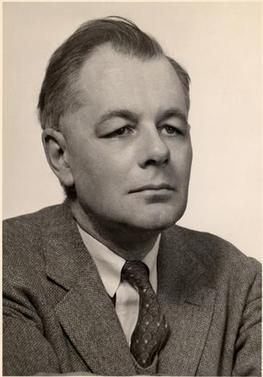
George Evelyn Hutchinson was a British ecologist sometimes described as the "father of modern ecology." He contributed for more than sixty years to the fields of limnology, systems ecology, radiation ecology, entomology, genetics, biogeochemistry, a mathematical theory of population growth, art history, philosophy, religion, and anthropology. He worked on the passage of phosphorus through lakes, the chemistry and biology of lakes, the theory of interspecific competition, and on insect taxonomy and genetics, zoo-geography, and African water bugs. He is known as one of the first to combine ecology with mathematics. He became an international expert on lakes and wrote the four-volume Treatise on Limnology in 1957.
The International Biological Program (IBP) was an effort between 1964 and 1974 to coordinate large-scale ecological and environmental studies. Organized in the wake of the successful International Geophysical Year (IGY) of 1957-1958, the International Biological Program was an attempt to apply the methods of big science to ecosystem ecology and pressing environmental issues.
Patch dynamics is an ecological perspective that the structure, function, and dynamics of ecological systems can be understood through studying their interactive patches. Patch dynamics, as a term, may also refer to the spatiotemporal changes within and among patches that make up a landscape. Patch dynamics is ubiquitous in terrestrial and aquatic systems across organizational levels and spatial scales. From a patch dynamics perspective, populations, communities, ecosystems, and landscapes may all be studied effectively as mosaics of patches that differ in size, shape, composition, history, and boundary characteristics.
Cary Institute of Ecosystem Studies (Cary Institute), formerly known as the Institute of Ecosystem Studies, is an independent, not-for-profit environmental research organization dedicated to the scientific study of the world's ecosystems and the natural and human factors that influence them. The organization is headquartered in Millbrook, NY on a 2,000-acre (810 ha) research campus. Areas of expertise include disease ecology, urban ecology, freshwater ecology and provisioning, and forest health.
Landscape limnology is the spatially explicit study of lakes, streams, and wetlands as they interact with freshwater, terrestrial, and human landscapes to determine the effects of pattern on ecosystem processes across temporal and spatial scales. Limnology is the study of inland water bodies inclusive of rivers, lakes, and wetlands; landscape limnology seeks to integrate all of these ecosystem types.
David William Schindler,, was an American/Canadian limnologist. He held the Killam Memorial Chair and was Professor of Ecology in the Department of Biological Sciences at the University of Alberta in Edmonton, Alberta. He was notable for "innovative large-scale experiments" on whole lakes at the Experimental Lakes Area (ELA) which proved that "phosphorus controls the eutrophication in temperate lakes leading to the banning of phosphates in detergents. He was also known for his research on acid rain. In 1989, Schindler moved from the ELA to continue his research at the University of Alberta in Edmonton, with studies into fresh water shortages and the effects of climate disruption on Canada's alpine and northern boreal ecosystems. Schindler's research had earned him numerous national and international awards, including the Gerhard Herzberg Gold Medal, the First Stockholm Water Prize (1991) the Volvo Environment Prize (1998), and the Tyler Prize for Environmental Achievement (2006).

Stephen Russell Carpenter is an American lake ecologist who focuses on lake eutrophication which is the over-enrichment of lake ecosystems leading to toxic blooms of micro-organisms and fish kills.
F. Herbert Bormann was an American plant ecologist whose 1971 research within the Hubbard Brook Experimental Forest in New Hampshire with fellow scientists was credited with the discovery of acid rain. His research was one of the major contributory factors towards changes made in the United States' Clean Air Act in 1990. In 1993 he was awarded the Tyler Prize for Environmental Achievement and in 2003 he received the Blue Planet Prize, both awards alongside his colleague Gene Likens. His publications include 8 books and more than 200 journal articles.
John D. Aber is University Professor Emeritus of Natural Resources & the Environment at the University of New Hampshire, and was also for many years affiliated with the Institute for the Study of Earth, Oceans, and Space at UNH. His fields of study included Ecosystem Analysis and Modeling, Global Change, Acid Rain, Nitrogen Deposition and Sustainable Agriculture.
Margaret A. Palmer is a Distinguished University Professor in the Department of Entomology at the University of Maryland and director of the National Socio-Environmental Synthesis Center (SESYNC). Palmer works on the restoration of streams and rivers, and is co-author of the book Foundations of Restoration Ecology. Palmer has been an invited speaker in numerous and diverse settings including regional and international forums, science-diplomacy venues, and popular outlets such as The Colbert Report.

Robert Henry Peters was a Canadian ecologist and limnologist that championed a predictive approach to science in order to make quantitative models relevant to public needs. He proposed that predictive limnology could be an effective tool for producing empirical models about relevant processes and organisms in lakes. He was a Professor in the Biology Department of McGill University, Montreal, Canada from 1974 to his death in 1996.
Emily S. Bernhardt is an American ecosystem ecologist, biogeochemist, and professor at Duke University.
Amy D. Rosemond is an American aquatic ecosystem ecologist, biogeochemist, and Distinguished Research Professor at the Odum School of Ecology at the University of Georgia. Rosemond studies how global change affects freshwater ecosystems, including effects of watershed urbanization, nutrient pollution, and changes in biodiversity on ecosystem function. She was elected an Ecological Society of America fellow in 2018, and served as president of the Society for Freshwater Science from 2019-2020.
Christine Goodale is an ecosystem ecologist and an Associate Professor in the Department of Ecology and Evolutionary Biology at Cornell University. Goodale conducts research that studies the cycling of water, carbon, nitrogen and other nutrients through forest ecosystems.
Charles Remington Goldman is an American limnologist and ecologist.
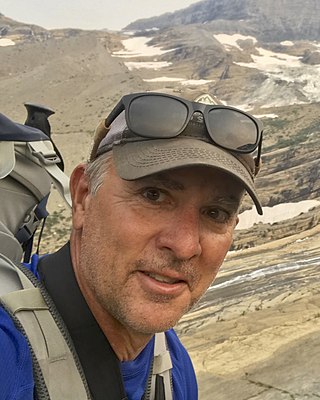
James Elser is an American ecologist and limnologist. He is Director & Bierman Professor of Ecology, Flathead Lake Biological Station, University of Montana and research professor, School of Life Sciences, Arizona State University. He is known for his work in ecological stoichiometry. In 2019, he was elected to the National Academy of Sciences.
Kathleen C. Weathers is an ecosystem scientist and the G. Evelyn Hutchinson Chair in Ecology at the Cary Institute of Ecosystem Studies. Her expertise focuses on understanding the ecology of air-land-water interactions. Weathers is the current elected President of the Ecological Society of America (2020-2021).
